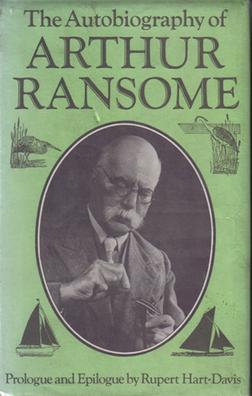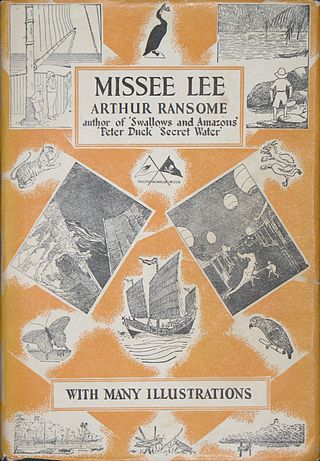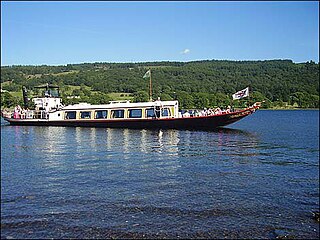Related Research Articles

Arthur Michell Ransome was an English author and journalist. He is best known for writing and illustrating the Swallows and Amazons series of children's books about the school-holiday adventures of children, mostly in the Lake District and the Norfolk Broads. The entire series remains in print, and Swallows and Amazons is the basis for a tourist industry around Windermere and Coniston Water, the two lakes Ransome adapted as his fictional North Country lake.

The Swallows and Amazons series is a series of twelve children's adventure novels by English author Arthur Ransome. Set in the interwar period, the novels involve group adventures by children, mainly in the school holidays and mainly in England. They revolve around outdoor activities, especially sailing. Literary critic Peter Hunt believes it "changed British literature, affected a whole generation's view of holidays, helped to create the national image of the English Lake District and added Arthur Ransome's name to the select list of classic British children's authors." The series remains popular and inspires visits to the Lake District and Norfolk Broads, where many of the books are set.

Coniston Water is a lake in the Lake District in North West England. It is the third largest by volume, after Windermere and Ullswater, and the fifth-largest by area. The lake has a length of 8.7 kilometres, a maximum width of 730 metres (800 yd), and a maximum depth of 56.1 m. Its outflow is the River Crake, which drains into Morecambe Bay via the estuary of the River Leven. The lake is in the unitary authority of Westmorland and Furness, and the ceremonial county of Cumbria.

The Old Man of Coniston is a fell in the Furness Fells of the Lake District in Cumbria, England, and is the highest point of the historic county of Lancashire. It is at least 2,632.62 feet (802.42 m) high, and lies to the west of the village of Coniston and the lake, Coniston Water. The fell is sometimes known by the alternative name of Coniston Old Man, or simply The Old Man. The mountain is popular with tourists and fell-walkers with a number of well-marked paths to the summit. The mountain has also seen extensive copper and slate mining activity for eight hundred years, and the remains of abandoned mines and spoil tips are a significant feature of the north-east slopes.

Oxenholme Lake District railway station in Oxenholme, near Kendal, Cumbria, England, is on the West Coast Main Line and at the start of the Windermere Branch Line to Windermere. The station, which serves as a main line connection point for Kendal and Windermere, is managed by Avanti West Coast and owned by Network Rail.

Peter Duck is the third book in the Swallows and Amazons series by Arthur Ransome. The Swallows and Amazons sail to Crab Island with Captain Flint and Peter Duck, an old sailor, to recover buried treasure. During the voyage the Wildcat is chased by another vessel, the Viper, whose piratical crew are also intending to recover the treasure.

Great Northern? is the twelfth and final completed book of Arthur Ransome's Swallows and Amazons series of children's books. It was published in 1947. In this book, the three families of major characters in the series, the Swallows, the Amazons and the Ds, are all reunited in a book for the first time since Pigeon Post. This book is set in the Outer Hebrides and the two familiar Ransome themes of sailing and ornithology come to the fore.

Swallowdale is a children's adventure novel by English author Arthur Ransome and first published by Jonathan Cape in 1931. The book features Walker siblings and Blackett sisters, camping in the hills and moorland country around a lake, with Maria Turner, the Blacketts' Great Aunt, acting as an antagonist. It is the second book in the Swallows and Amazons series; preceded by Swallows and Amazons and followed by Peter Duck.

Pigeon Post is an English children's adventure novel by Arthur Ransome, published by Jonathan Cape in 1936. It was the sixth of twelve books Ransome completed in the Swallows and Amazons series. He won the inaugural Carnegie Medal from the Library Association, recognising it as the year's best children's book by a British subject.

Swallows and Amazons is a children's adventure novel by English author Arthur Ransome first published on 21 July 1930 by Jonathan Cape. Set in the summer of 1929 in the Lake District, the book introduces the main characters of John, Susan, Titty and Roger Walker (Swallows); as well as their mother, Mary; and their baby sister, Bridget. We also meet Nancy and Peggy Blackett (Amazons); their uncle Jim, commonly referred to as Captain Flint; and their widowed mother, Molly Blackett. It is the first book in the Swallows and Amazons series, followed by Swallowdale.

The Picts and the Martyrs is the eleventh book in Arthur Ransome's Swallows and Amazons series of children's books. It was published in 1943. This is the last completed book set in the Lake District and features the Blackett sisters, the Amazons and the Callum siblings, Dick and Dorothea, known as the Ds. Ransome's most native character, the Great Aunt also features prominently as do many aspects of Lakeland life. The Dog's Home is based on a small stone hut built in the woods above Coniston Water close to Ransome's then residence.

We Didn't Mean to Go to Sea is the seventh book in Arthur Ransome's Swallows and Amazons series of children's books. It was published in 1937. In this book, the Swallows are the only recurring characters. They are staying with their Mother and baby sister Bridget in a new location, Pin Mill on the River Orwell upstream from the ports of Felixstowe and Harwich and are in Suffolk to meet their Father, Navy Commander Ted Walker who is returning overland from a posting in Hong Kong to take up a new posting at Shotley. (In Swallows and Amazons his ship was at Malta but under orders for Hong Kong.

Missee Lee is the tenth book of Arthur Ransome's Swallows and Amazons series of children's books, set in 1930s China. The Swallows and Amazons are on a round-the-world trip with Captain Flint aboard the schooner Wild Cat. After the Wild Cat sinks, they escape in the boats Swallow and Amazon, but are separated in a storm. Both dinghies eventually end up in the lair of the Three Island pirates—Chang, Woo and Lee—where they are held prisoner by the unusual Missee Lee, the leader of the Three Island pirates.

Peel Island is one of the three islands of Coniston Water in the English Lake District, Cumbria. The two others are Fir Island and Oak Island. It is most famous for being one of the inspirations for Arthur Ransome's Wild Cat Island. Today, it is a popular tourist destination, and belongs to the National Trust.

The steam yacht Gondola is a rebuilt Victorian, screw-propelled, steam-powered passenger vessel on Coniston Water, England. Originally launched in 1859, she was built for the steamer service carrying passengers from the Furness Railway and from the Coniston Railway. She was in commercial service until 1936 when she was retired, being converted to a houseboat in 1946. In 1979, by now derelict, she was given a new hull, engine, boiler and most of the superstructure. She is back in service as a passenger boat, still powered by steam and now operated by the National Trust.
Nancy Blackett is a fictional character in nine of the twelve juvenile novels in Arthur Ransome's Swallows and Amazons series of books. She acts as captain of the dinghy, Amazon and usually directing her friends in their various adventures. Nancy apparently has no real-world counterpart as an inspirational source for Ransome but appears to be completely the author's creation. Nancy is sometimes critically viewed as a subversive character for girl readers. The character appeared in a 1963 BBC television adaptation of Swallows and Amazons as well as in the 1974 and 2016 film adaptations of the book.

Nibthwaite is a village in the South Lakeland District in the county of Cumbria in the northwest of England. It is in the civil parish of Colton, and on the east side of Coniston Water. It is in the historic county of Lancashire.
Swallows and Amazons is a 1963 BBC children's television series based on the 1930 novel of the same name by Arthur Ransome, about the holiday adventures of two groups of children, the Swallows (Walkers) and the Amazons (Blacketts), sailing on a lake and camping on an island in the Lake District in the 1930s.

Swallows and Amazons is a 2016 British family adventure film directed by Philippa Lowthorpe and written by Andrea Gibb, based on Arthur Ransome's 1930 children's novel of the same name. The film stars Andrew Scott, Rafe Spall, Kelly Macdonald, Jessica Hynes, and Harry Enfield. Principal photography began on 21 June 2015 in the Lake District. The film, which was released on 19 August 2016, is the third audiovisual adaption of the novel; the first being a 6-part BBC TV series in 1963 and the second a 1974 film version.
References
- ↑ Literary Norfolk
- ↑ https://www.geograph.org.uk/photo/155564 Location map
- ↑ Chambers, Ronald (2009). The Last Englishman: The Double Life of Arthur Ransome. London: faber and faber. pp. 338, 339. ISBN 978-0-571-22261-2.